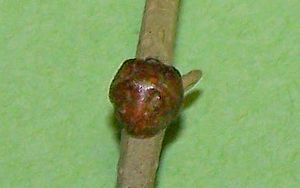Saissetia oleae facts for kids
Quick facts for kids Saissetia oleae |
|
|---|---|
 |
|
| Scientific classification | |
| Genus: |
Saissetia
|
| Species: |
oleae
|
| Synonyms | |
|
Coccus oleae Olivier, 1791 |
|
The olive scale (scientific name: Saissetia oleae) is a tiny insect. It is also known by its older name, Coccus oleae. This insect belongs to a group called scale insects. They are part of the Coccidae family.
The olive scale is one of the main pests that harm olive trees. It feeds on the sap of the tree. Other common olive tree pests include the olive fruit fly and the olive moth. Even though it mostly affects olive trees, the olive scale can also attack other plants. These include citrus trees, oleanders, and sago palms.
Contents
Discovering the Olive Scale
One of the first scientists to study the olive scale in a modern way was an Italian naturalist named Giuseppe Maria Giovene. In 1807, he wrote a book called Descrizione e storia della cocciniglia dell'ulivo. In this book, he proved that the insect was common in certain parts of Italy, like Apulia.
At that time, many people didn't know much about the male olive scale. But Giovene made an important discovery: he found the male insect! Before this, a big science book from Paris in 1816 even stated that "the male is not known." Giovene's work helped scientists learn more about this tiny pest.
Life Cycle of the Olive Scale
The adult female olive scale has a soft body. It hides under a dark grey or brownish-black covering. This covering grows and gets harder as the female gets older. In most places, there are no male olive scales. The females can lay eggs without a male, which is called parthenogenesis.
A female olive scale can lay up to 2,500 eggs! She keeps these eggs safe under her hard covering. When the eggs hatch, tiny baby insects called "crawlers" come out. These crawlers can move around. They leave their mother's covering and spread to other parts of the plant.
The crawlers grow by shedding their skin twice. After these two molts, they become adult olive scales. All stages of the olive scale's life, from crawler to adult, feed on the host plant. They do this by sucking out the plant's sap, which is like its blood.
Where the Olive Scale Lives
The olive scale might have first come from South Africa. But now, it has spread all over the world. It has been found feeding on 113 different kinds of plants from 49 plant families!
Besides being a big problem for olive trees, it is also a major pest for citrus trees. This is especially true in places like the Mediterranean area, California, and Florida.
Scientists have found ways to control the olive scale. For example, a tiny parasitic wasp called Metaphycus helvolus is a natural enemy of the olive scale. This wasp is originally from South Africa. It has been brought to places like California. There, it has greatly helped to reduce the number of olive scales in citrus farms.
See also
 In Spanish: Cochinilla de la tizne para niños
In Spanish: Cochinilla de la tizne para niños

